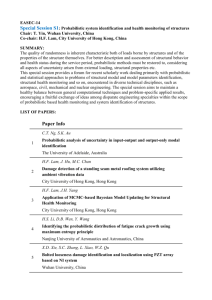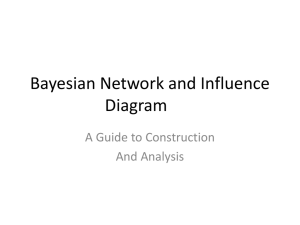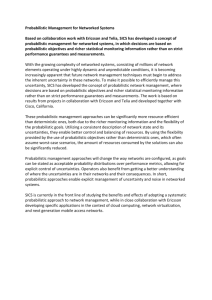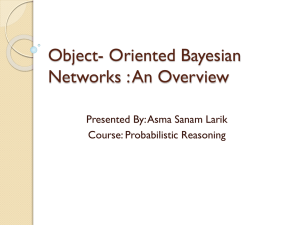Appendix J Quantitative approaches: recognized advantages This
advertisement
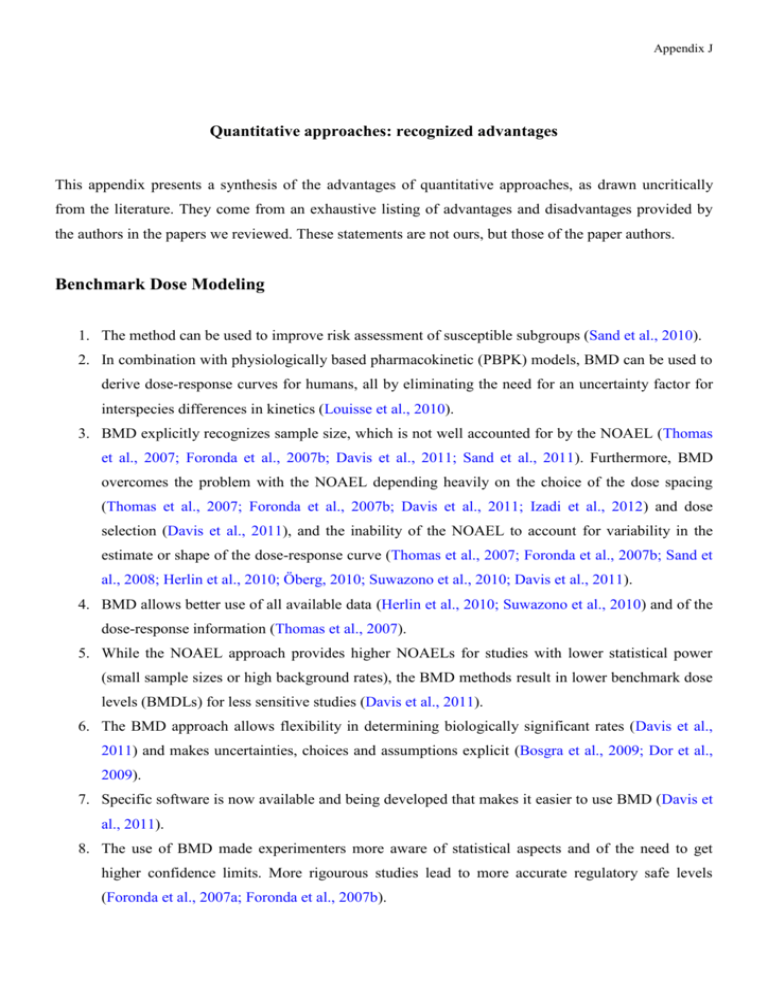
Appendix J Quantitative approaches: recognized advantages This appendix presents a synthesis of the advantages of quantitative approaches, as drawn uncritically from the literature. They come from an exhaustive listing of advantages and disadvantages provided by the authors in the papers we reviewed. These statements are not ours, but those of the paper authors. Benchmark Dose Modeling 1. The method can be used to improve risk assessment of susceptible subgroups (Sand et al., 2010). 2. In combination with physiologically based pharmacokinetic (PBPK) models, BMD can be used to derive dose-response curves for humans, all by eliminating the need for an uncertainty factor for interspecies differences in kinetics (Louisse et al., 2010). 3. BMD explicitly recognizes sample size, which is not well accounted for by the NOAEL (Thomas et al., 2007; Foronda et al., 2007b; Davis et al., 2011; Sand et al., 2011). Furthermore, BMD overcomes the problem with the NOAEL depending heavily on the choice of the dose spacing (Thomas et al., 2007; Foronda et al., 2007b; Davis et al., 2011; Izadi et al., 2012) and dose selection (Davis et al., 2011), and the inability of the NOAEL to account for variability in the estimate or shape of the dose-response curve (Thomas et al., 2007; Foronda et al., 2007b; Sand et al., 2008; Herlin et al., 2010; Öberg, 2010; Suwazono et al., 2010; Davis et al., 2011). 4. BMD allows better use of all available data (Herlin et al., 2010; Suwazono et al., 2010) and of the dose-response information (Thomas et al., 2007). 5. While the NOAEL approach provides higher NOAELs for studies with lower statistical power (small sample sizes or high background rates), the BMD methods result in lower benchmark dose levels (BMDLs) for less sensitive studies (Davis et al., 2011). 6. The BMD approach allows flexibility in determining biologically significant rates (Davis et al., 2011) and makes uncertainties, choices and assumptions explicit (Bosgra et al., 2009; Dor et al., 2009). 7. Specific software is now available and being developed that makes it easier to use BMD (Davis et al., 2011). 8. The use of BMD made experimenters more aware of statistical aspects and of the need to get higher confidence limits. More rigourous studies lead to more accurate regulatory safe levels (Foronda et al., 2007a; Foronda et al., 2007b). Appendix J 9. BMD can be used to develop relative potency values for the risk assessment of mixtures (Öberg, 2010). 10. In contrast to NOAEL, the confidence interval around BMD can be calculated, providing risk managers with additional information (Sand et al., 2008; Öberg, 2010; Gollapudi et al., 2012). Furthermore, BMD can be calculated from experiments without an NOAEL, so complementary studies are not needed (Sand et al., 2008; Herlin et al., 2010; Öberg, 2010; Izadi et al., 2012). Distributions of Toxicity Indicators (NOAELs, CTDs, CEDs) 1. Dobbins et al. (2008) developed a probabilistic ecological hazard assessment (PEHA) using a chemical toxicity distribution (CTD) approach for comparing sensitivities of different estrogenic activity assays and calculating the probabilities of finding compounds that elicit estrogenic effects below a given concentration. While it is usually difficult to compare different assays by simply comparing endpoints, because of the variability in the estrogenic activity of compounds, the CTD approach allowed them to create a distribution that included that variability. 2. From a more practical perspective, PEHA can be used to determine the probability that an untested compound shows estrogenic properties below a set threshold exposure concentration. Furthermore, this method allows a probabilistic treatment of effects and risk without needing a distribution for exposure. Hence, CTDs can be used to assess the hazard associated with compounds for which exposure data is limited (Dobbins et al., 2008; Dobbins et al., 2009). 3. The CTD can be used to assess the hazards for an entire group of compounds, when enough data exist to derive a representative distribution (Dobbins et al., 2009). 4. CTDs can be used with read-across data and for data-poor substances for which data exist for numerous similar compounds. In this case, CTDs make it possible to select a screening point value to develop environmental safety values for a specific endpoint (Williams et al., 2011). 5. Distributions of individual critical effect doses provide the risk manager with transparent and useful information—even more because consequences of risk reduction measures can be anticipated and therefore included in the assessment of costs and benefits of risk reduction measures (Bos et al., 2009). Probabilistic Effect (Safety / Assessment) Factors 1. The ecotoxicological effect factors obtained with probabilistic methods are more accurate (Van Zelm et al., 2009). Appendix J 2. Probabilistic effect factors make it possible to quantify uncertainties (Van der Voet and Slob, 2007; Van Zelm et al., 2009). Species Sensitivity Distributions 1. One of the main advantages highlighted in the literature is that SSDs can use all of the available single-species toxicity data (Liu et al., 2009; Jin et al., 2012a) 2. SSD allows extrapolation from the single-species to the ecosystem level (Olsen et al., 2011; Sánchez-Bayo and Goka, 2012). 3. The ecotoxicological effect thresholds obtained with SSD are more accurate than deterministic effect indicators like the no observed effect concentration (NOEC) (Van Zelm et al., 2009). Because they can express effects of chemicals on different species and at different trophic levels, SSDs have greater statistical significance and ecological meaning than classical deterministic quotients (Wang et al., 2008; Fox and Billoir, 2013). Compared to QSAR, SSDs have higher ecological significance because all available single species data are combined to predict concentrations that affect a certain percentage in an ecosystem (Dom et al., 2010). 4. SSD allows quantification of uncertainties (Verdonck et al., 2007; Van Zelm et al., 2009; Qin et al., 2013). 5. SSD emphasizes those species that are the most affected by chemical exposure (Dom et al., 2010) and for this reason they are more practical for protecting most of the species in an ecosystem (Wang et al., 2008). 6. SSDs derived with parametric approaches are mathematically simple (Wang et al., 2008). 7. SSDs and probabilistic methods more generally provide more credible results (Verdonck et al., 2007; Wang et al., 2009) and give risk managers more information (Verdonck et al., 2007) and the ability to select appropriate percentile levels and confidence levels (Jin et al., 2011; Jin et al., 2012a). More generally, conclusions of probabilistic techniques are useful for risk management. 8. According to some authors, SSD makes it possible to assess risks from multiple chemicals (Wang et al., 2009; Qin et al., 2013). Others, though, feel SSD cannot be applied to most chemical mixtures (Sánchez-Bayo and Goka, 2012). Probabilistic Exposure Assessment: Frequentist methods 1. By explicitly stating the inferences, preferences, facts and assumptions, probabilistic techniques facilitate decision making (Bogen et al., 2009) and provide more credible results (Wang et al., 2009). According to Bogen et al. (2009), probabilistic exposure assessment could be used in toxic Appendix J tort litigations, to estimate the likelihood that a specified number of cases of harm were associated with a specific exposure to a chemical. Probabilistic approaches provide the risk manager with useful information in a transparent form; for example, by making it possible to estimate the consequences of risk reduction measures beforehand (Erdal et Carollo, 2007; Vitrac and Leblanc, 2007; Verdonck et al., 2007; Barros and Rubin, 2008; Bos et al., 2009; Cao et al., 2011; Phong et al., 2011; Wang et al., 2011; Persoons et al., 2012). 2. Probabilistic techniques make it possible to assess risk from multiple chemicals (Wang et al., 2009) 3. Probabilistic exposure models can account for uncertainty and variability at different stages of the model, using all the available data. Therefore, they provide more accurate and realistic results (Boobis et al., 2008; McKinlay et al., 2008). Indeed, while deterministic risk assessments provide a single point estimate, probabilistic risk assessments generate a range of values from probability distribution functions. This range is accompanied by an average estimate and the degree of conservatisms of those estimates (Valcke and Krishnan, 2011b). 4. Probabilistic techniques produce outputs with more ecological meaning, makes better use of the available data, identifies most significant factors contributing to risk, can provide an alternative to field testing or helps focus on key uncertainties for further study in the field, and promotes better science by considering multiple possibilities (Alonso et al., 2008; Macedo-Sousa et al., 2009). 5. Probabilistic techniques have been used to predict multimedia chemical partitioning directly from molecular information (Martinez et al., 2010) 6. The ability to determine which parameters contribute most to uncertainty in the results makes it possible to minimize these uncertainties by improving measurements and model calculations (Arnot et al., 2008) 7. Probabilistic techniques make it possible to identify sensitive sub-populations (Schleier et al., 2009), populations exposed to high levels of chemicals (Morales et al., 2011), and the percentage of a population that might be at risk (Trudel et al., 2011), and make it possible to characterize uncertainty and/or variability through a population in relation to toxicological thresholds of the respective substance or certain parameters; for example, pharmacokinetics (Liao et al., 2007b; Sioen et al., 2007; Trudel et al., 2011). 8. Probabilistic techniques also provide an opportunity to propagate parameter uncertainty through the model (Trudel et al., 2011) and quantify variability (Alonso et al., 2008; Persoons et al., 2012; Sidorenko, 2011), including spatial variability (Hollander et al., 2012). 9. Monte Carlo (MC) simulation methods can handle nonlinear problems (Xiao et al., 2008) and a substantial number of parameters (Mesa-Frias et al., 2013). Appendix J Probabilistic Exposure Assessment: Bayesian methods 1. Bayesian methods have been successfully used for PBPK models for various chemicals, calibrating model parameters (Chen et al., 2010) or for estimating parameters in complicated PBPK models (Allen et al., 2007; Chen et al., 2010). 2. The Bayesian framework can be used to reduce uncertainty in parameters of PBPK models (Bois et al., 2010; Chen et al., 2010), to distinguish inter-individual variability in PBPK models (Chen et al., 2010), to account for multiple exposures in situations in which there is incomplete measurement information (Kennedy, 2010; Chen, Y-C. et al., 2012). More generally, Bayesian methods like Markov Chain Monte Carlo or hierarchical Bayesian regression analysis provide more accurate estimates of model parameters (Saloranta et al., 2008; Qiu et al., 2009; Tanaka et al., 2010; Görlitz et al., 2011; Hoque et al., 2012). Comparison between model results and observations help eliminate improbable values of parameters (Saloranta et al., 2008), calibrate the models (Saloranta et al., 2008; Schenker et al., 2009) and consider correlations between different sources of exposure in case of multiple exposures (Kennedy, 2010). 3. More generally for models, Bayesian techniques allow simultaneous estimation of model parameters and characterization of their uncertainty and variability (Chiu et al., 2009; Kennedy, 2010) 4. Bayesian methods allow use of large datasets (Chiu and Ginsberg, 2011) and can be used in situations where data is poor. Bayesian approaches incorporate expert opinion through prior distributions for parameters, which is especially useful in data-poor situations (Kennedy, 2010). 5. Bayesian methods provide more objectivity and transparency; for example, by clearly separating data used for prior distributions and data used for model calibration, by using non-informative priors when prior data is lacking, or by using interspecies scaling that accounts for prediction error (Chiu et al., 2009). The judgments made by experts to supplement poor quality data, which are also used in frequentist methods, are transparent in Bayesian approaches (Tielemans et al., 2007). 6. Certain techniques minimize subjectivity in Bayesian methods; for example, by using noninformative distributions for parameters lacking prior information (Chiu et al., 2009) 7. Bayesian methods are flexible and can adapt to different cases (Cressie et al., 2007). They can also integrate various types of data from previous experiments (Allen et al., 2007; Mörk and Johanson, 2010). 8. Bayesian techniques are made easier by recent developments in software (Mutshida et al., 2008). For example, the Bayesian Matbugs Calculator (BMC) developed by Qin et al. (2013) makes it easier to determine the best fitting model for toxicity and exposure data and uncertainty calculations, which is a crucial step in ecological risk assessment. Appendix J 9. Though Bayesian methods can be computationally demanding, according to Cressie et al. (2007), such difficulties should be surmountable. The developments of Markov Chain Monte Carlo techniques facilitate sampling from distributions with complex algebraic forms (Allen et al., 2007; Mutshida et al., 2008). 10. The use of Bayesian techniques can identify vulnerable subpopulations (Cressie et al., 2007) or particular locations in a watershed (Hoque et al., 2012) that need particular risk management action. 11. Bayesian techniques provide a framework for learning from evidence as it accumulates (Mutshida et al., 2008; Bois et al., 2010). If priors and data models are appropriate, the relative strength of information in the dietary survey and residue concentration data for different food types will be reflected in the posterior results (Kennedy, 2010). 12. The advantage of Bayesian over frequentist approaches is that the former does not require any assumptions about the variables themselves, because priors are based on knowledge and the degree of certainty about variables (Bogen et al., 2009). 13. Bayesian updating techniques can help calibrate a model by adjusting several model inputs to many different field measurements simultaneously, and take uncertainty of field measurements, into account to avoid overfitting (Schenker et al., 2009) Probability bounds approach applied to exposure 1. Can be used when data is poor, and to compare the upper and lower bounds of a distribution (Nong and Krishnan, 2007). Fuzzy logic methods for uncertainty in exposure or effects 1. Fuzzy logic methods have proven useful to assess threats from multiple substances to aquatic ecosystems (Ocampo-Duque et al., 2012) 2. They are able to integrate dissimilar criteria and diverse datasets, all by accounting for subjectivity (Ocampo-Duque et al., 2012) 3. They make it possible to model expert human knowledge (Ocampo-Duque et al., 2012) and allow for linguistic management of information, in the form of linguistic variables that are particularly useful when information cannot be expressed with numbers (Mesa-Frias et al., 2013) 4. They can be very useful in situations in which there is epistemic uncertainty (lack of knowledge) (Mesa-Frias et al., 2013) 5. Fuzzy logic-based methods can synthesize complex information that can only be interpreted by a Appendix J few experts, and translate it into more understandable indicators that can be understood by environmental managers and the general public (Angulo et al., 2012; Lindahl and Bockstaller, 2012). 6. The use of fuzzy logic-based techniques eliminates the need to make assumptions about the type of probability distribution, as required in probabilistic analysis. Furthermore, hybrid approaches can be developed by combining probability density functions with fuzzy numbers (Agwa et al., 2013). 7. Fuzzy logic methods can be combined with Bayesian methods. Jenab et al. (2012) used a fuzzy Bayesian air quality monitoring model to determine whether the air quality at a work station is normal or abnormal, and included uncertainty that cannot be accounted for in traditional air quality models. Multi-criteria decision analysis (MCDA) 1. Risk managers can make decisions more confidently when a broad group of criteria can be considered (Passuello et al., 2012) 2. Criteria can be developed even when there is limited data (Coutu et al., 2012) 3. A MCDA method (the Fuzzy PROMETHEE method) (Zhang et al., 2009): has been used for ranking sites according to their risks has been found to better reflect uncertainties specific to a particular site can express uncertainties in their available form, i.e., qualitative or quantitative can express criteria in their own measurement units reflects the decision makers interpretation of each criterion and its importance to the final result. It is easy to use and can generate a graphical profile that is easy to understand (Zhang et al., 2009). Sensitivity analysis applied to exposure or effects 1. Sensitivity analysis might be used to determine key areas of uncertainty for which additional information is needed to reduce uncertainty (Avagliano and Parrella, 2009; Bogen et al., 2009). 2. Sensitivity analysis makes it possible to focus the available resources on the parameters that are responsible for producing reliable results (Barton et al., 2007; Avagliano and Parrella, 2009; Vezzaro et al., 2011) 3. Global sensitivity analysis provides insight into the importance of each factor and interactions between factors (Vezzaro et al., 2011) Appendix J 4. Sensitivity analyses can help calibrate models (Barton et al., 2007). 5. Global sensitivity analysis (GSA) can help to distinguish the relative contributions of uncertainty and variability of parameters to the variance in the predicted outcome. This helps provide more data on uncertain parameters, which is not possible for variable ones (Avagliano and Parrella, 2009). 6. Sensitivity analyses make it possible to investigate the influence of modeling choices and assumptions on the results (Crump et al., 2008; Nadal et al., 2008; Bosgra et al., 2009) 7. In multi-criteria methods, sensitivity analysis makes the influence of expert subjectivity in choosing MCDA criteria and model rules more transparent. Thus, sensitivity analysis is of great help in evaluating and calibrating models, and makes it possible to check whether the model is appropriate for the problem (Passuello et al., 2012). 8. Sensitivity analysis makes it easier to understand model outcomes (Passuello et al., 2012). 9. Sensitivity analysis makes it possible to address potential biases and weaknesses in the study design (Chevrier et al., 2013).


